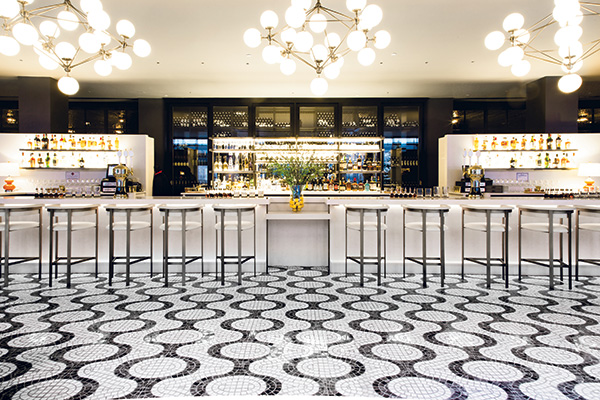Flooring can be the least exciting part of the restaurant design process, but it’s ultimately the element that everyone — from customers to staff to vendors — interacts with most. It has a significant impact on people’s ability to safely and successfully navigate the space, and also plays a big role in helping create a restaurant’s ambiance.
Functionality, however, should be considered first and foremost, and that’s typically health department and safety driven, according to Linda Midden, director of design for Webb Design in Tustin, Calif.
To help select safe flooring options, it’s important to understand local codes and try to follow standards established by such organizations as The Tile Council of North America. This helps designers navigate a variety of safety-related considerations, including making sure the product has the proper wet coefficient.
“It’s just being diligent in your research,” Midden says. “There is no guarantee. You need to test the flooring. Get a sample and pour some water on it. We do that all the time and sometimes the operators will decide they want something more.”
Although flooring continues to be a safety-first specification, that should not stifle a designer’s creativity. “The choices today are so much more diverse,” Midden says. “Flooring definitely plays a large role in aesthetics. We can make a statement with design of the tile, the size of the tile and more.”
That’s true even in the back of the house. For years, simple terra cotta red quarry tile was the standard choice for that area. Today, however, many designers opt for neutral kitchen tile colors, such as taupe, gray and beige — particularly as more kitchens are at least partially exposed. “You will even see some patterns. Usually it does not cost much more to add an accent color or a little variety in the back of the house,” Midden says. “The health department now likes the brighter colors because they make dirt more visible and that usually prompts staff to clean it.”
Common Mistakes to Avoid
When specifying flooring, Midden lists three common mistakes to avoid.
- Making a choice based on aesthetics without considering the application. “Knowing what you can and can’t put into a foodservice operation is critical,” Midden says. In other words, just because it makes a great design statement doesn’t mean it’s a good fit from a practical usage standpoint.
- Placing a flooring product where it is not intended to go. “Not doing your homework sets you up to fail. Work with your reps to find out where a product should and should not go,” Midden says. “If a product is not on their specification they will let you know. For example, can it stand up to the carts and foot traffic that the back of house experiences?” And be aware of how people will flow through the facility. “There are some circulation areas, such as entrances and exits, where you would not want to put carpet because it will wear. Hard surfaces are best in these areas.”
- Picking colors that are too light. “You will see all of the drips and spills,” Midden says. Patterns help in this regard.
Selection Tips and Trends
With so many flooring options on the market today, how can designers choose the right ones for their restaurant projects? “Overall, you have to take into account the size of the space, the design vision, acoustics, aesthetics, and durability and cleanability,” Midden advises. For example, “If it’s a high-ceiling space, acoustics could become an issue so we might want to do a combination of tile and carpet.” One common flooring trend today is the use of carpet tiles in the front of the house. This allows for design flexibility and the tiles are easy to maintain. If one gets soiled, the restaurant can simply swap it out for another one. Stained and natural concrete represent popular options, too. “That’s very trendy and urban,” Midden says. “More clients are asking us to consider these options, too.” Wood-grain porcelain tiles are also very current, Midden adds. “You get the durability and don’t have the issues of maintaining real wood.” And that brings up another popular flooring option: the use of wood. “Everyone is going more organic, authentic and timeless. Wood provides that warmth and sustainable image,” Midden notes. While very attractive, restaurant operators also need to understand the upkeep wood floors require, which can impact how a facility deploys its labor.

